by Ian Skellern
Welcome to the 2019 edition of Quill & Pad’s early Grand Prix d’Horlogerie de Genève predictions in which the team picks favorites and explains why.
The panelists are:
Ian Skellern (IS), co-founder and technical director
Joshua Munchow (JM), resident nerd writer
Martin Green (MG), resident gentleman
Sean Li (SL), editorial director of Blackbird Watch Manual
Tim Mosso (TM), watch specialist and media director of pre-owned watch retailer Watchbox
Note: as jury members, editor-in-chief Elizabeth Doerr and resident collector GaryG do not take part in these early predictions.
The GPHG foundation describes the Aiguille d’Or as “. . . rewarding the best overall watch among all the categories (best in show), also deemed the most representative of the watch industry as a whole. It is the most prestigious award.”
SL: And we finally come to the Aiguille d’Or. I’ve been a bit flummoxed by this category in the past because it’s really down to individual interpretations. To me it should be a whole package, a watch that combines a number of criteria that stand out, and not to only focus on either the most complicated or a particular technical breakthrough; in short, it should be a so-called “grail” watch. And allow me to get another detail off my chest: the GPHG foundation tries as much as possible to avoid a particular watch winning more than one prize, and as such the watch that wins the Aiguille d’Or is removed from its category.
However, that does mean that the watch that then wins the relevant category didn’t actually win, it came second in the voting. Perhaps this is something to consider changing in future? In any case, on with our selection!
JM: The entire GPHG comes down to the Aiguille d’Or and what an honor it is to win. Out of the hundreds of watches entered, only one can win the coveted title and call itself the best watch of the year.
The most interesting aspect of the Aiguille d’Or is how the winner won’t always be the most complicated, expensive, or groundbreaking. To win the Aiguille d’Or, a watch needs to be a fantastic all-around watch and have that little something extra, that je ne sais quoi. That is different for everyone, so the winner of the Aiguille d’Or is fairly hard to predict, and I think in my history of guessing I may have never predicted this one correctly because it is just so wide open.
This year I expect no different as there are so many fabulous pieces that, depending on the discussions among the jury, it could go many ways. So I’ll just leave it with the pieces I feel stood out the most and keep my fingers crossed that I stumble upon the eventual winner.
MG: For me, picking the watch that should take the Aiguille d’Or home is obvious. Mine is a surprising conclusion as, perhaps this year, even more than ever, there are so many watches deserving of the top prize. However, when I first held this watch, I was blown away, and that is a thing that doesn’t happen that often anymore.
TAG Heuer Carrera Tourbillon Nanograph
JM: When a watch debuts an innovation in material science, it is a big deal. When that innovation seeks to replace the nearly sacred hairspring, that is something else.
The Carrera Tourbillon Nanograph is a watch sporting a carbon-composite hairspring that TAG Heuer hopes will supplant both the traditional Nivarox hairspring and the modern wonder that is silicon, and do so at the price of the ubiquitous Nivarox nonetheless. With aims to have the carbon-composite hairspring commercialized for its regular collection in the very near future, this watch may mark a turning point in horological know-how.
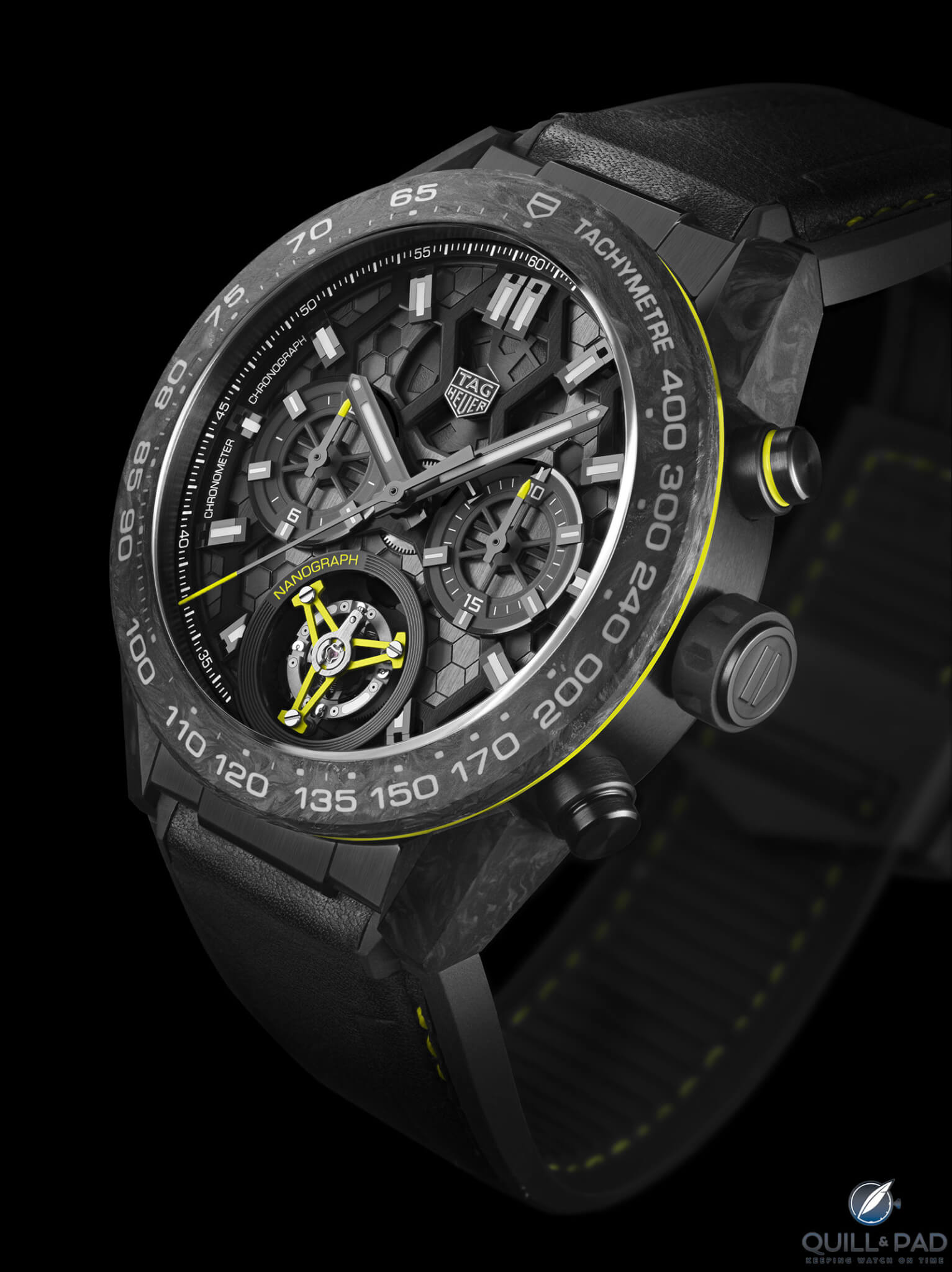
TAG Heuer Carrera Calibre Heuer 02T Tourbillon Nanograph
JM: However, the design is rather bold (read divisive), and outside of the hairspring the watch is right in line with a lot of what TAG Heuer already offers. I don’t know if it has what it takes to win the top prize, but I would not be surprised if it got the nod either. Still, my pick goes to another.
IS: The Carrera Tourbillon Nanograph has the technology to be a top contender, but I feel that its looks let it down. I can see it doing well, but not well enough to take the Aiguille d’Or.
Further reading:
TAG Heuer Carrera Calibre Heuer 02T Tourbillon Nanograph: New Carbon-Composite Tech Offering Big Advantages
For more information, please visit www.gphg.org/horlogerie/en/watches/tag-heuer-carrera-tourbillon-nanograph.
Quick Facts TAG Heuer Carrera Tourbillon Nanograph
Case: 45 x 16.5 mm, black PVD titanium and forged carbon
Movement: automatic Caliber Heuer 02T with in-house carbon-composite hairspring, one-minute tourbillon, C.O.S.C. chronometer certification, 65-hour power reserve, 4 Hz/28,800 vph frequency
Functions: hours, minutes, seconds; chronograph
Remark: comes with integrated watch winder in packaging
Price: $25,500/24,900 Swiss francs
Zenith Defy Inventor
JM: Like the Carrera Tourbillon Nanograph, the Zenith Defy Inventor seeks to upend traditional watchmaking with not only a balance-less movement, but a frequency unseen across the industry: a very swift 18 Hz (129,600 vph).
If the escapement proves reliable and practical to manufacture, it might dramatically shift the landscape for high-frequency movements across the industry. That’s a very big IF and when looking at past advancements, inventions this different are rarely adopted outright, if ever, as a standard method.
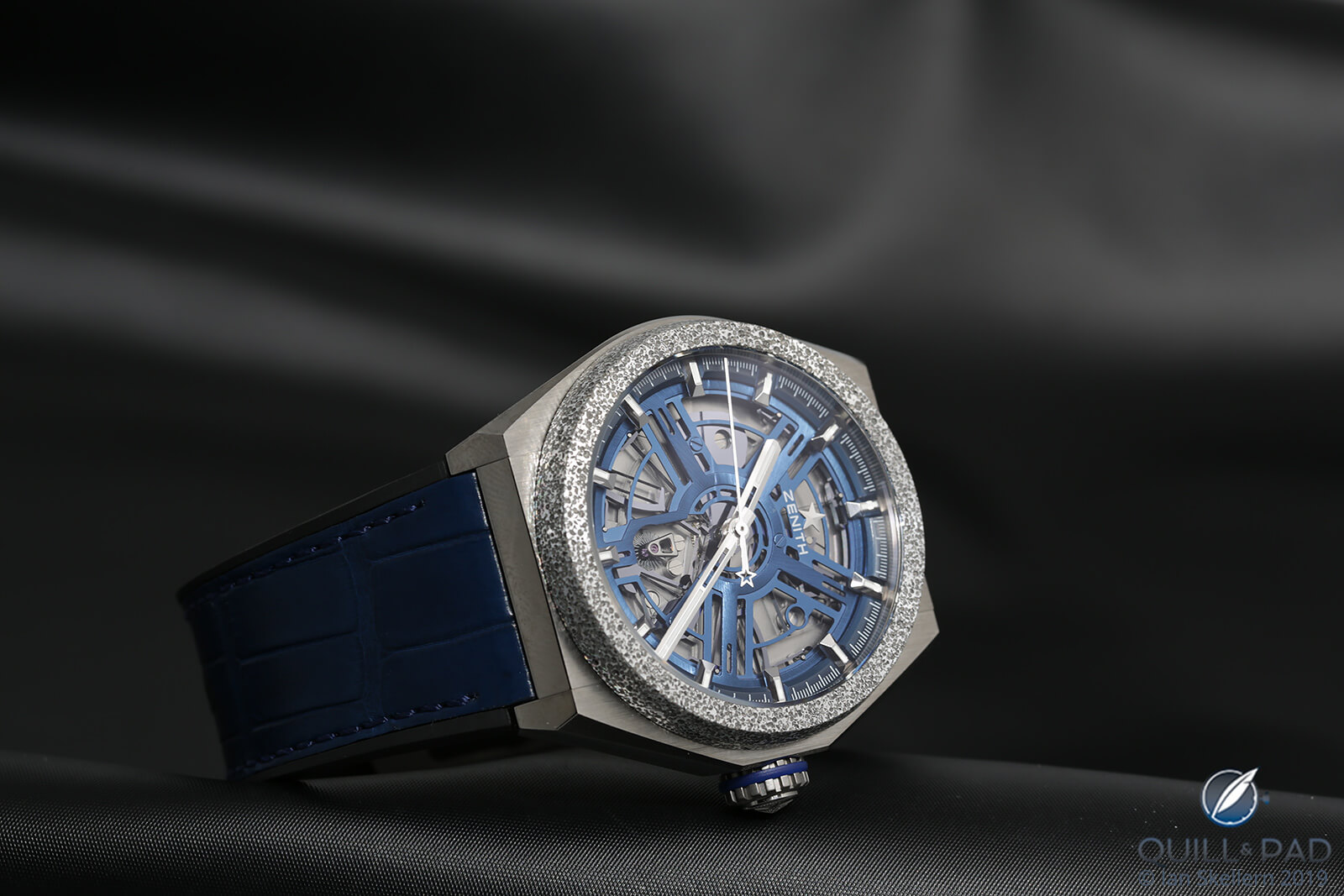
Zenith Defy Inventor
JM: So while I think the Inventor is a tremendous accomplishment in material science and mechanical engineering of compliant mechanisms, it has a tenuous future in the present. Like the TAG Heuer I would not be surprised if this watch won the top prize, especially if the jury appreciates the possibilities, but I’m reserving my pick for another.
IS: In another year, the Zenith Defy Inventor would stand out at the top of its class. But not this year.
Further reading:
Zenith Defy Inventor: Experimental Compliant Tech Goes Into Serial Watch Production
The Zenith Defy Lab Highlights Technology That Could Change Future Watchmaking
For more information, please visit www.gphg.org/horlogerie/en/watches/defy-inventor.
Quick Facts Zenith Defy Inventor
Case: 44 x 14.5 mm, titanium with Aeronith bezel
Movement: automatic Zenith Caliber ZO 9100 with monolithic silicon oscillator; 32.8 mm diameter; 148 components including 18 jewels; 18 Hz/129,600 vph frequency, power reserve 50 hours
Functions: hours, minutes, hacking seconds
Price: 18,900 Swiss francs
Hermès Arceau L’Heure de la Lune
JM: I think this watch might be a crowd favorite and definitely a journalist favorite for 2019. Hermès has been killing it in recent years, and with the launch of the Arceau L’Heure de la Lune the brand left any pretense behind that it isn’t serious about high-end, complicated watchmaking. The movement development for the Arceau L’Heure de la Lune is incredible and clever and shows that the brand maintains aesthetic decisions above ease of engineering.
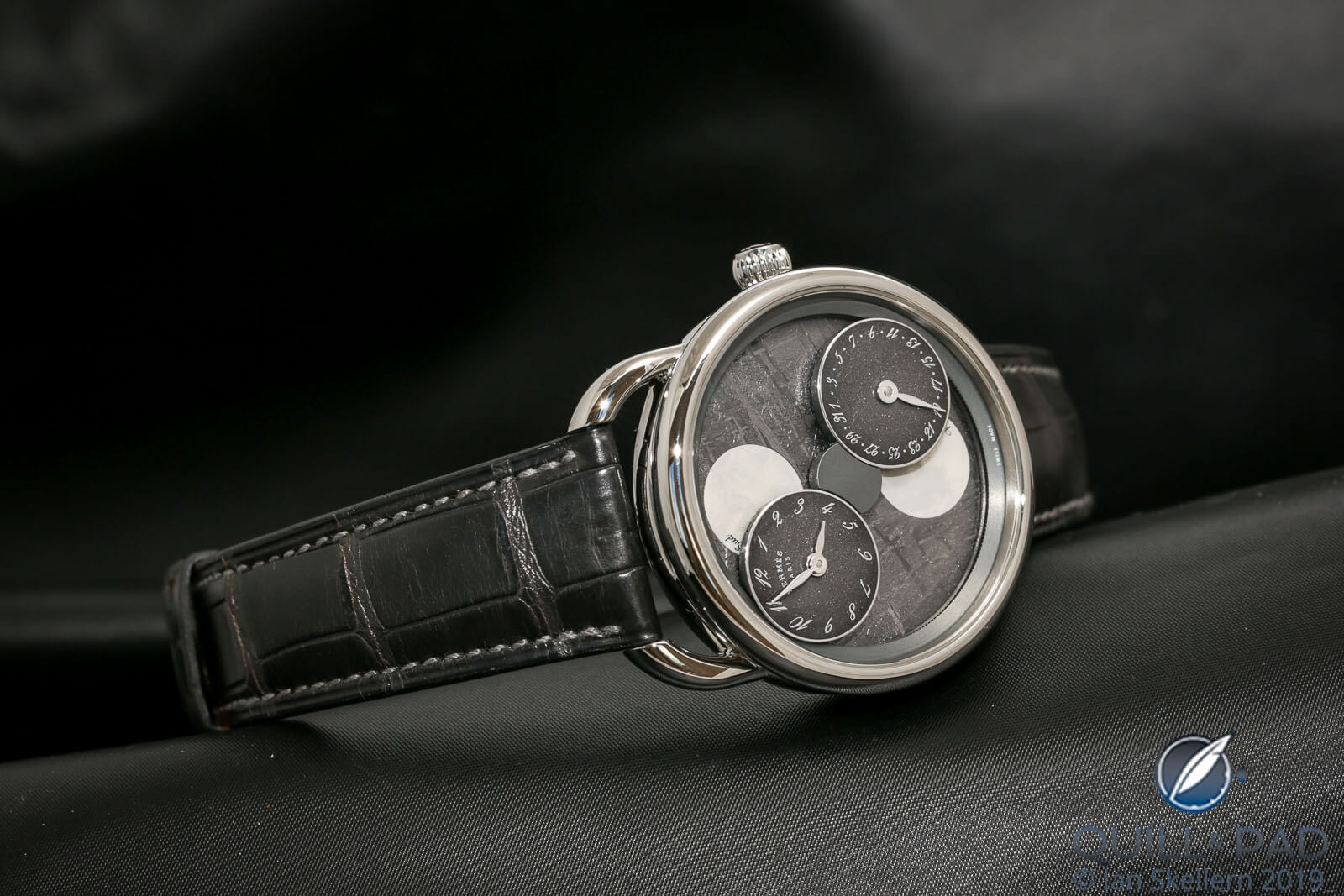
Hermès Arceau L’Heure de la Lune with meteorite dial
JM: This is demonstrated by the two wandering dials that have no visible attachment method, drastically increasing the difficulty of assembly but maintaining an extremely clean presentation. For looks and mechanics, this watch is a strong contender for the Aiguille d’Or, and I would be pumped to see it win.
However, this year is extremely stacked with competition, and I fear it may be too narrowly focused (with a moon phase and calendar) to take the honor. My pick goes to another, but not for a minute would I say this watch isn’t deserving of the win.
IS: I’m a big fan of the Hermès L’Heure de la Lune and expect it to do very well at the 2019 GPHG. But I can’t see it taking the big prize.
Further reading:
Hermès Arceau L’Heure De La Lune: And Pegasus Flies On The Moon
For more information, please visit www.gphg.org/horlogerie/en/watches/arceau-lheure-de-la-lune.
Quick Facts Hermès Arceau L’Heure De La Lune
Case: 43 x 13.27 mm, white gold
Dial: meteorite with grey lacquered subdials and mother-of-pearl moons; blued hands
Movement: automatic Hermès Caliber H1837 with Chronode module; 4 Hz/28,800 vph frequency
Functions: hours, minutes; date, double moon phase as seen from both the northern and southern hemispheres
Limitation: 100 pieces
Price: 26,000 Swiss francs
Urwerk AMC
JM: The Urwerk AMC is by far the most audacious and ambitious watch in the 2019 GPHG. Not only does the watch come with an entire atomic clock for reference, but a fully mechanical sympathique connection that allows the mechanical AMC to be updated every night to the most accurate possible current time. There can be no other watch that is more accurate in the competition and still remain mechanical.
This watch has no modern analogue and is easily the most technically impressive undertaking seen this year. So why is it that I don’t think it will win? Well, I don’t think it can’t; in fact, I think it is probably in the top three without any discussion simply due to the accomplishment of its creation.
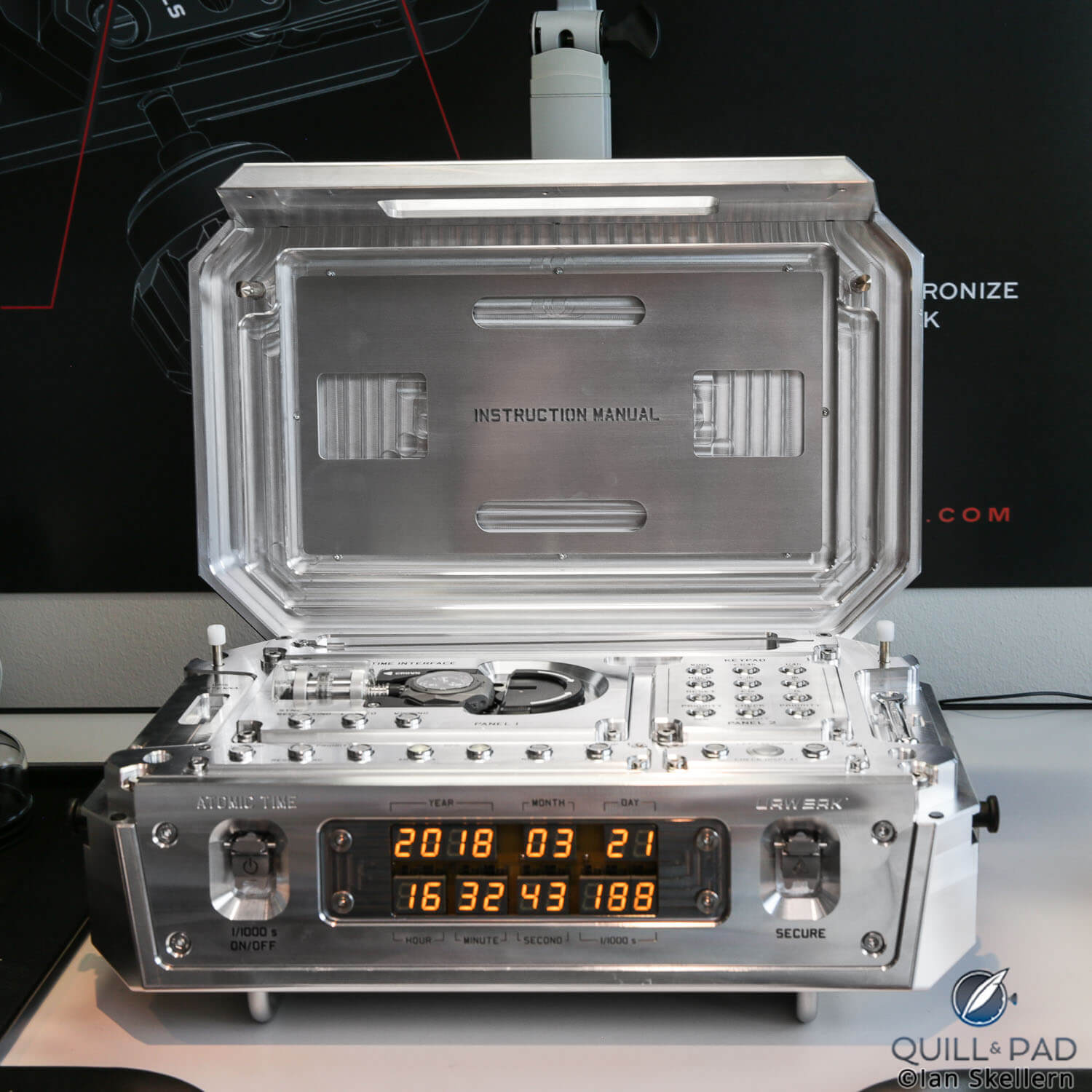
Urwerk AMC docked with atomic clock
No, the reason I don’t know if it will win the Aiguille d’Or is simply because for it to be fully awesome it requires a giant atomic clock that is plugged into the wall, and that means that the watch is only half of the amazingness. The jury may not care, but based on the past winners, I feel like a singular package is more attractive than a watch that needs an accessory to be its best self.
Don’t get me wrong: this watch is a modern marvel and deserves a permanent spot in the halls of horological history. It has no equal. But the jury is a fickle thing, and with collectors, journalists, and watchmakers all debating over personal values, the sci-fi AMC might prove too far from center. It could win, no doubt, but I’m not sure. And so my pick goes to another.
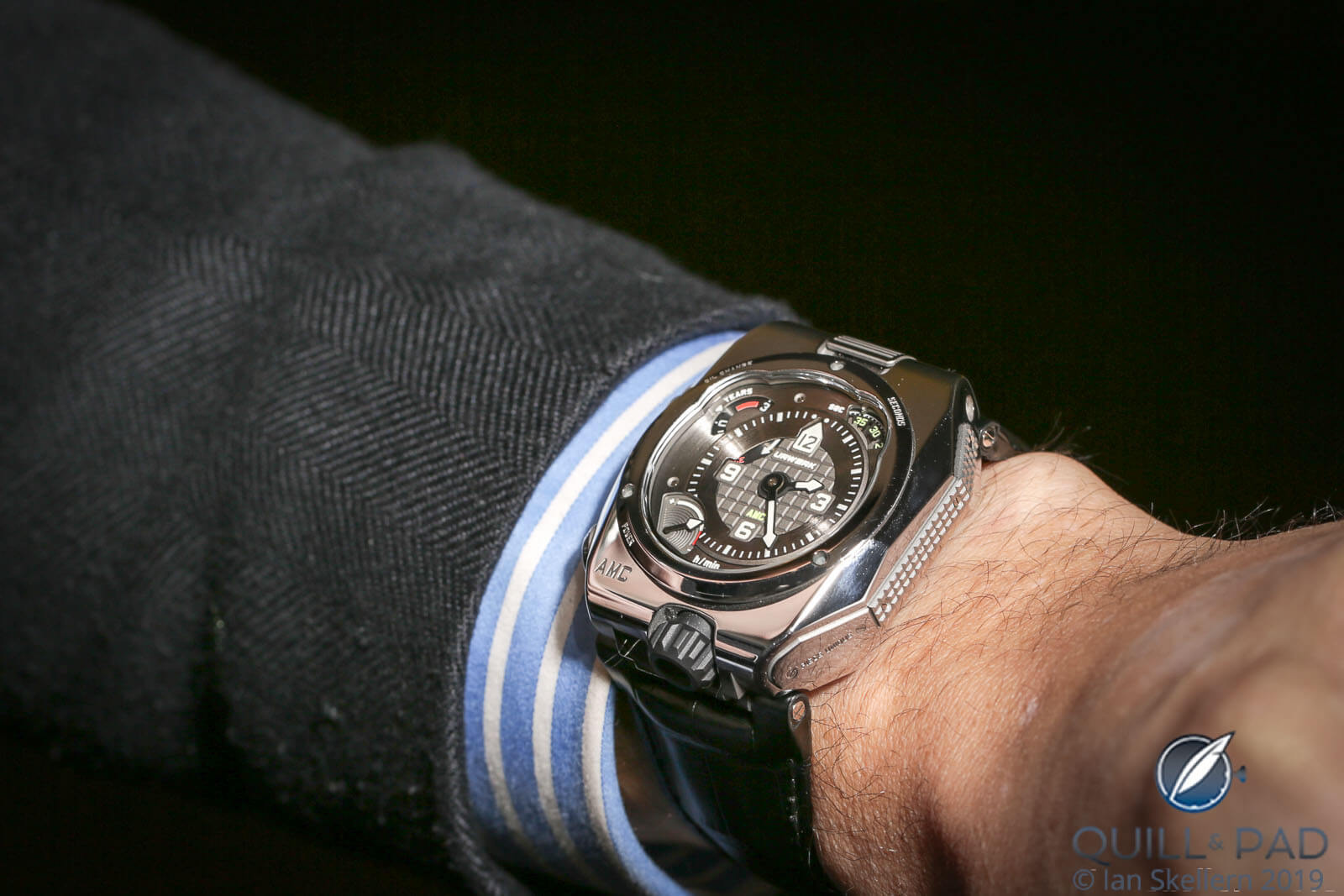
Urwerk AMC on the wrist
IS: I use the word “audacious” to describe the Urwerk AMC as well, Joshua, and note that Abraham-Louis Breguet didn’t expect his original Sympathique master clock to travel, as with the EMC atomic master clock. Where I differ from you is in feeling that that’s precisely the type of audacity that should be encouraged by, and well deserves, the 2019 Aiguille d’Or. Urwerk’s AMC is my prediction for the top prize.
Further reading:
Urwerk AMC: Atomic (Clock) Mechanical Control Is A 21st Century Version Of Abraham-Louis Breguet’s Sympathique Clocks But Much, Much Better (Geiger Counter Not Included)
The Difference Between Urwerk’s EMC And A Toyota Prius (Not As Obvious As You May Think)
Back In Black: First Live Photos Of The ‘Smart’ Urwerk EMC Black
Presenting EMC2 Time Hunter By Urwerk: Ugly Duckling Takes First Step To Swanhood
For more please visit www.gphg.org/horlogerie/en/watches/amc.
Quick Facts Urwerk AMC
Case: 46 x 52 x 17.9 mm, stainless steel
Movement: manual winding Urwerk caliber, ARCAP linear balance wheel, 4 Hz/28,800 vph frequency, serially operating twin spring barrels, 80-hour power reserve, automatically wound by cradle in Sympathique style
Functions: hours, minutes; years, balance rate adjustment
Remark: comes with atomic master clock base unite
Limitation: 3 pieces
Price: 2,750,000 Swiss francs
MB&F Legacy Machine FlyingT
JM: The MB&F Legacy Machine FlyingT represents the best chance that a women’s watch has to win the Aiguille d’Or since 2001, when Vacheron Constantin’s Lady Kalla took the prize as the only other time a women’s watch has won it.
For the past 17 editions of the GPHG, a male-oriented watch has won (which isn’t exactly surprising) and it may still ring true this year. But MB&F knows how to make watches that people fall in love with, and the FlyingT is a watch that I feel pretty much everyone has loved. It is distinctly feminine and not simply a diamond-studded men’s watch, yet I have heard many men say that without the diamonds they would totally wear it. The watch is fantastic, supremely wearable, features unique horology, and covers many of the bases one might look for in a “watch of the year.”
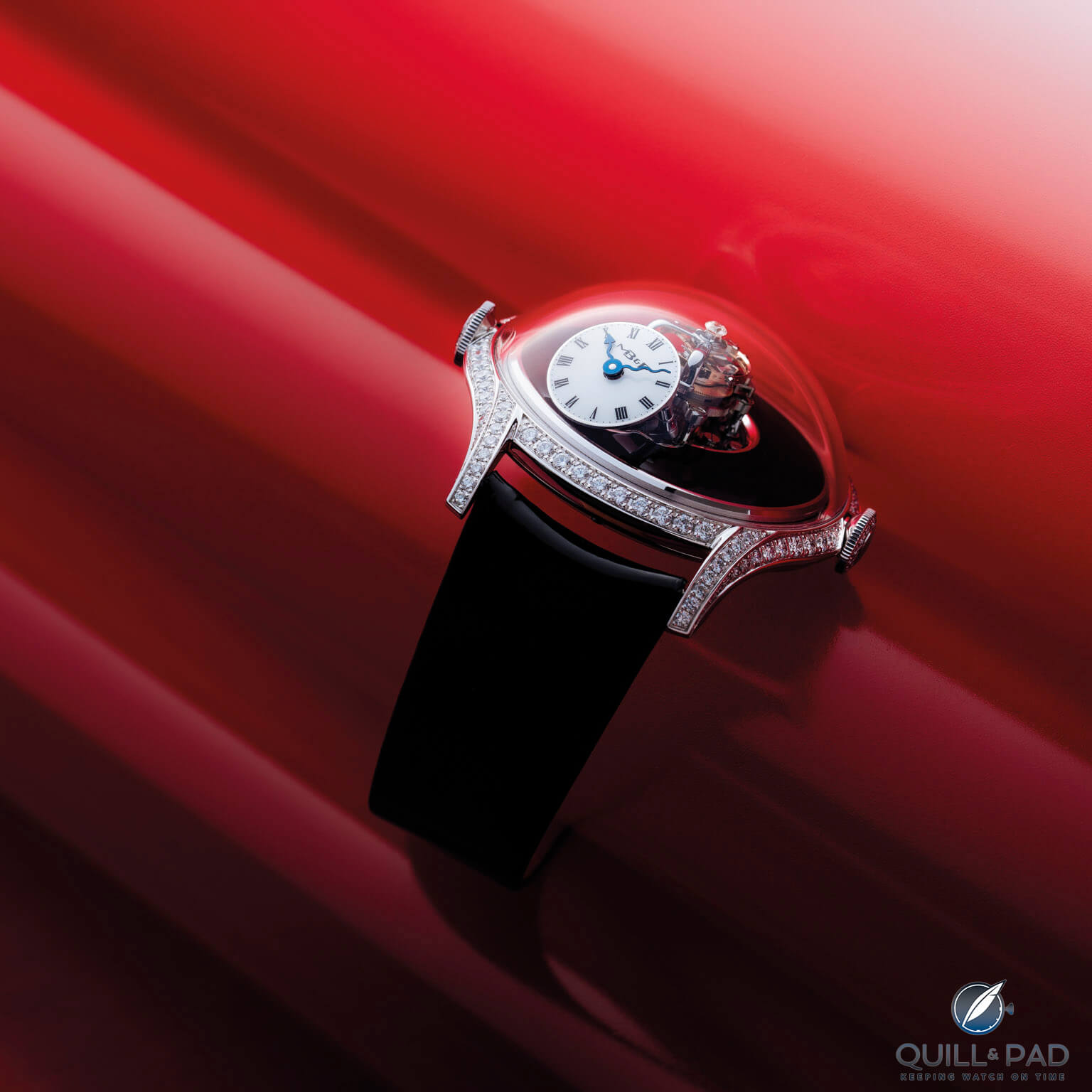
MB&F Legacy Machine FlyingT Black Lacquer
Along with the Urwerk AMC, I think the Legacy Machine FlyingT is in the top three candidates to win the Aiguille d’Or, and if it doesn’t win best Ladies Watch then I think we can assume that will be the reason why. But I am a bit hesitant to pick it for my winner for one reason, and not the reason you might think.
MB&F has yet to win an Aiguille d’Or and so to win with the very first women’s watch from the brand seems like a longshot. And, yet, that would be the most poetic way to win as well. I’m on the fence, and so while I’m choosing another watch as my winner, I’d say the MB&F and the Urwerk are tied for my guess of who might win if my top choice does not.
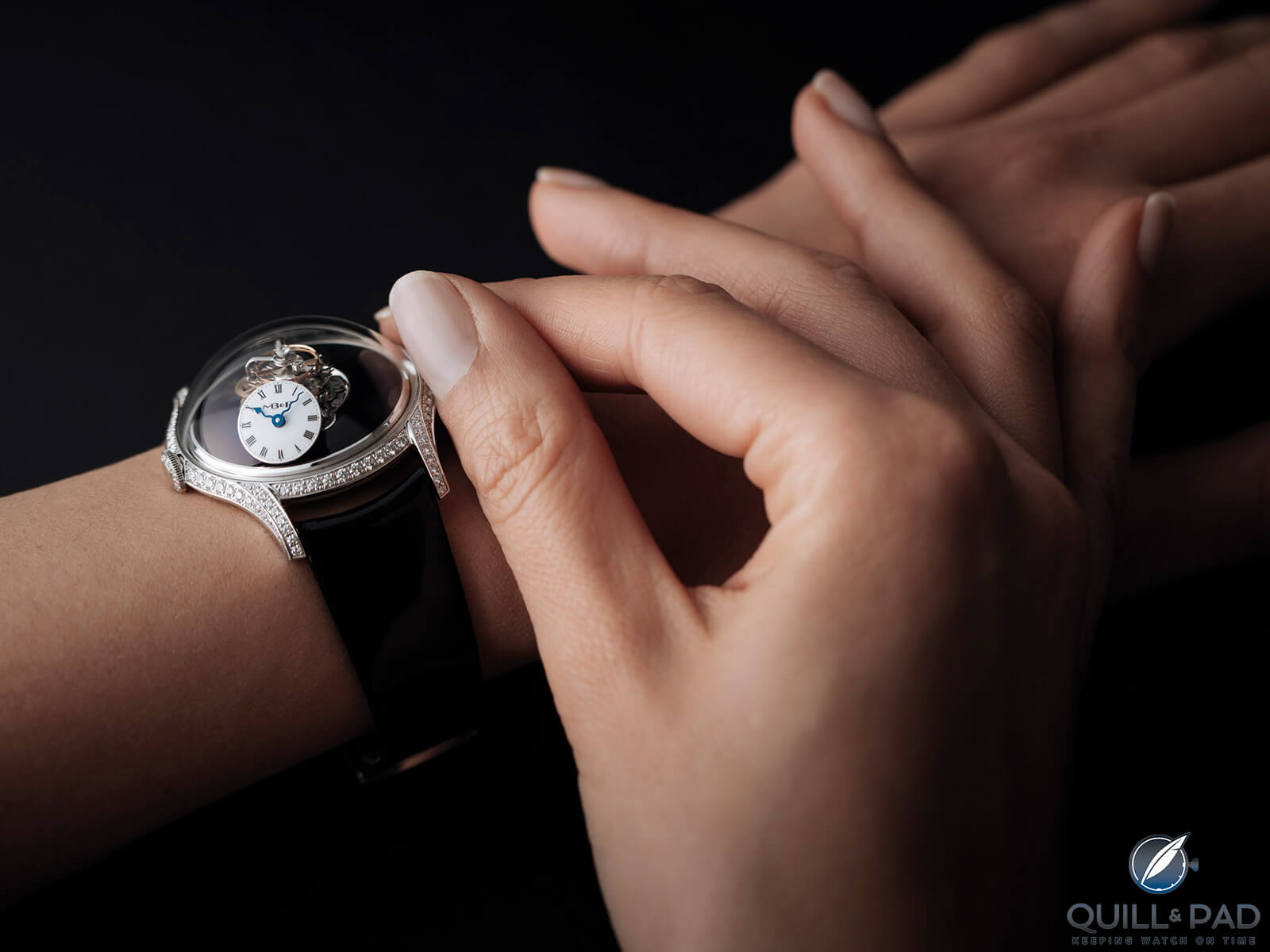
MB&F Legacy Machine FlyingT Black Lacquer on the wrist
IS: If the MB&F FlyingT took the Aiguille d’Or, I’d be on my feet cheering. The FlyingT not only redefines women’s watches, it revolutionizes watch architecture and design. And it looks absolutely fantastic. With this level of competition, it’s easy to imagine the jury playing it safe, but I doubt it would take much to swing the jury into appreciating the FlyingT. And making a stand for women. It’s not my pick for Aiguille d’Or, but the gap is hairspring fine.
MG: For me, MB&F gets to take the Aiguille d’Or home for the Legacy Machine FlyingT, Ian. The brand is known for its unique and outstanding creations. Still, this watch with its stacked movement, superbly designed case, and largest domed sapphire crystal since the Corum Bubble, unites art with high-end watchmaking in a single object. I also love the way that the small dial is seemingly placed against the movement, almost at random, and with little visible connection to it. Even the oscillating weight is a real work of art. The only thing I dislike is that it is positioned as a ladies’ piece, while I would call it unisex. For me this is the best MB&F yet, and one of the best watches of recent history.
Further reading:
MB&F Legacy Machine FlyingT: A Sensational Ladies Watch Both Technically And Visually Scintillating
For more information, please visit www.gphg.org/horlogerie/en/watches/legacy-machine-flyingt.
Quick Facts MB&F Legacy Machine FlyingT
Case: 38.5 x 20 mm, white gold, set with brilliant-cut or baguette-cut diamonds
Movement: automatic caliber with three-dimensional vertical architecture, central flying 60-second tourbillon, four-day power reserve, 2.5 Hz/18,000 vph frequency
Functions: hours, minutes, seconds
Price: CHF 108,000 (black lacquer dial); CHF 135,000 (pavé diamonds); CHF 298,000 (baguette-cut diamonds), all prices excluding sales tax
Vacheron Constantin Traditionnelle Twin Beat perpetual calendar
SL: There are certainly a few standouts from this year’s entries. The one that I’m most impressed with, though, is the Vacheron Constantin Traditionnelle Twin Beat Perpetual Calendar. It’s not a record-setter, but I’m impressed with the innovative thinking that enables the owner to have the watch in his or her rotation without needing to make any adjustment to the time or the calendar over a two-month period without resorting to an external accessory. Also, the basic concept with the dual frequencies enabling an extended power reserve is fundamentally easy to understand, but probably far from trivial to construct. And I like the unusual layout of the perpetual calendar and the watch’s overall aesthetic.
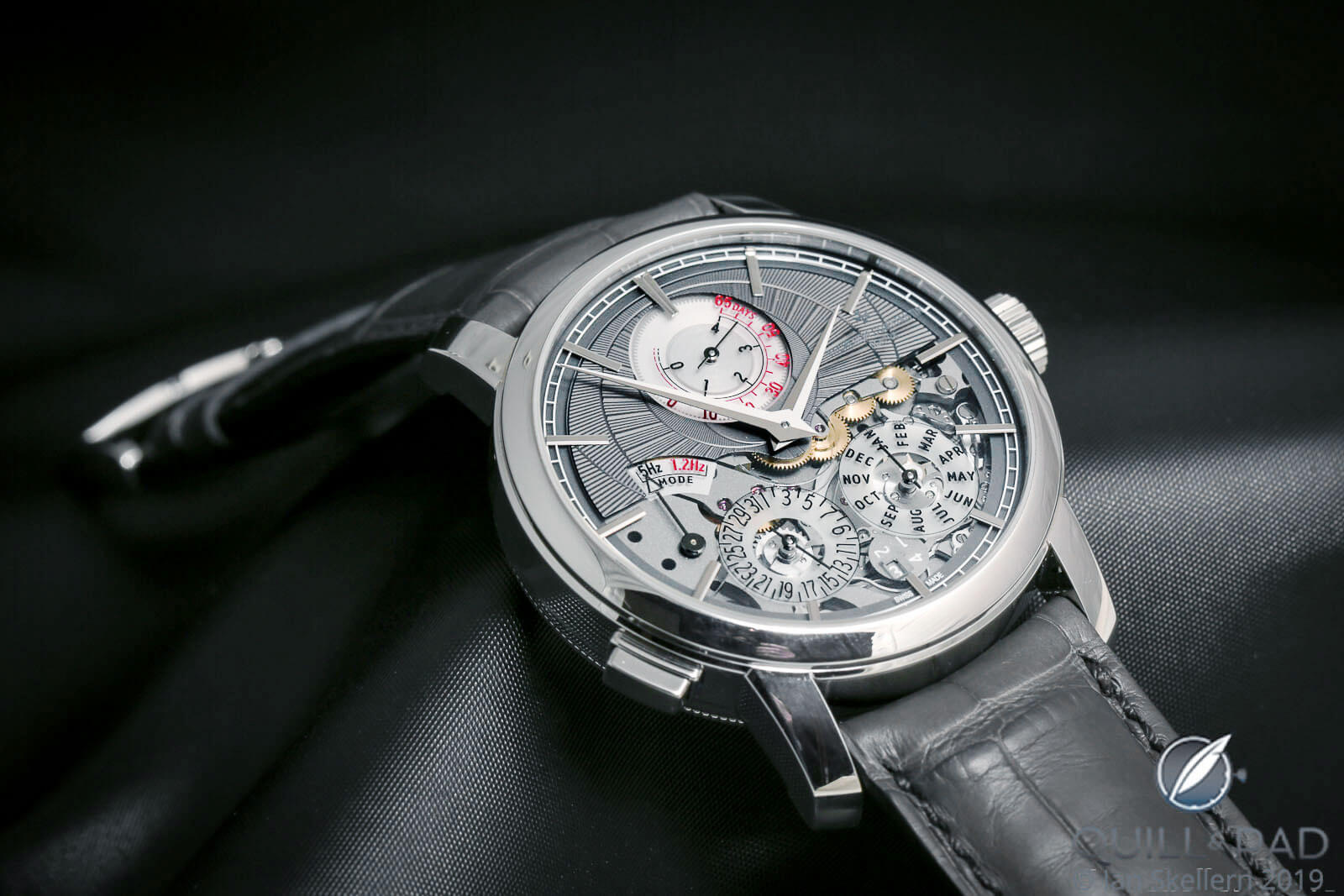
Vacheron Constantin Traditionelle Twin Beat
TM: Vacheron Constantin’s Tradionnelle Twin Beat Perpetual Calendar: direct hits of this magnitude turn dinosaurs into oil wells. No watch was more discussed or more innovative in 2019.
If any doubts linger as to the wisdom of awarding the top prize to a concept watch, take heart that the Twin Beat was introduced with both a production VC reference number – 3200T/000P-B578 – and a projected retail price: CHF 283,000. This will reach production in the foreseeable future; Vacheron Constantin already has published A USER MANUAL for the erstwhile concept.
Recall that other watches with comparable power reserves have looked nothing like this trim 42 x 12.3 mm Vacheron Constantin, and you can grasp how transformative the Twin Beat’s technology is. Previous attempts to endow watches with more than one month’s worth of autonomy have spawned unwieldy monsters like the Lange 31 and the Hublot LaFerrari – both of which required specialized tools to wind. Neither of those watches can be worn with a straight face; the Twin Beat can be worn with a suit.
An intricate perpetual calendar is the ideal match for Vacheron Constantin’s breakthrough in power reserve, so even the first-run application of this innovation feels logical and practical. There’s real value here for the collector, and the 65-day power reserve is just the headlining feature; many subsidiary innovations enable the big number while recommending the watch in their own right.
Caliber 3610 QP incorporates Vacheron Constantin’s first use of a reduced-friction silicon escape wheel on its low-beat “standby” balance; two drivetrains and two independent escapements derive power from the same barrel via two differentials; thanks to the single barrel, a solitary power reserve indicator incorporates a dual-model function to trace either a 96-hour arc or a 65-day (1,560-hour) duration; VC retained premium instant-jump calendar functions that draw one fourth of the power previously required; the entirety includes rose-lathe guilloche on a solid gold dial, sapphire disc displays, and Geneva hallmark finish on the innovative mechanism.
Above all, the Twin Beat’s appearance isn’t awkward or dictated by engineering; its style is charismatic, handsome, and alluring. In time, the price of this technology will come down; the sky-high thrill of wearing this machine never will.
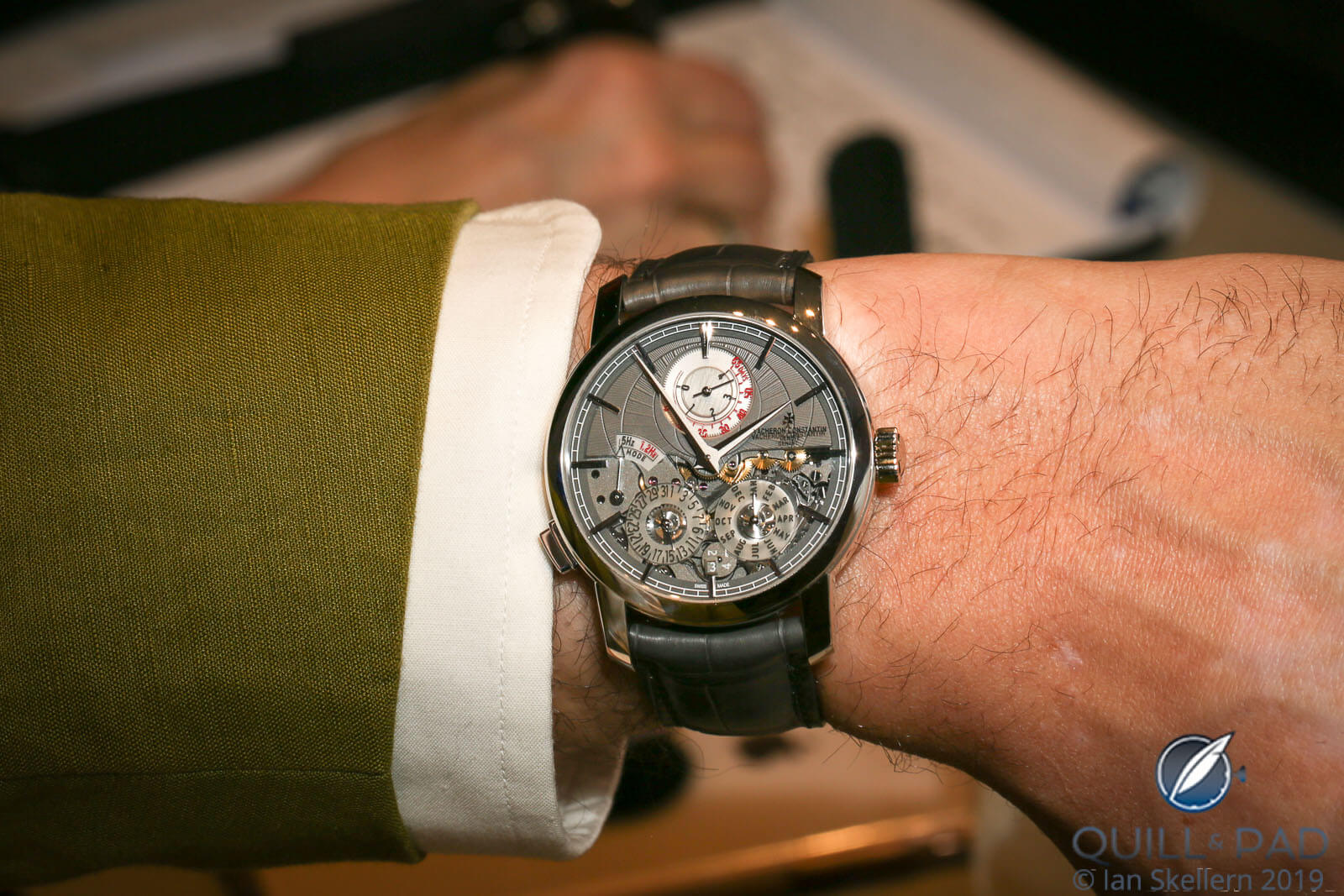
Vacheron Constantin Traditionnelle Twin Beat on the wrist
IS: I strongly suspect that the Vacheron Constantin Traditionnelle Twin Beat perpetual calendar will be the watch to beat in this competition. A revolutionary technical achievement in a contemporary setting by one of the most traditional of brands. I can easily imagine the Twin Beat being a shoo-in for the Aiguille d’Or. It has everything going for it. But for me it comes in a close second.
JM: This is a hard choice to pick, but I feel like an old-school brand may just be the top choice this year, and the Vacheron Constantin Traditionnelle Twin Beat seems the likely choice. It demonstrates a dramatic shift in how people think about big power reserves on a watch, especially one that crucially requires that it does not stop lest resetting the indications may be annoying at best. With the ability to change between a normal balance and one oscillating at a glacier’s pace of 1.2 Hz to increase the power reserve to 65 days, this piece solves an old problem in a cleverly new way while providing a very classic and traditional wearing experience. The design is modern yet reserved, and the mechanics are ingenious to say the least.
I know that there are many incredible watches this year: some that are more mechanically impressive, some that are more aesthetically pleasing, and some that simply provide a better value proposition. But I feel like the Twin Beat has enough of everything to get everyone on board. I know that the jury uses runoff-style voting and so that is why I feel this watch may very well win.
Even if only one person picks it to win outright, I could see everyone picking it as their second choice since it has something to please everybody, and if there is enough disagreement about the top spot, this piece could be the common ground the jury agrees upon. That is why I am picking it to win because among a field of standouts the Traditionnelle Twin Beat might be the most universal for the jury to land on.
Further reading:
Vacheron Constantin Traditionnelle Twin Beat: User-Controlled Dual Frequency Offers Greater Precision, Less Wear, And Option Of Two-Month Power Reserve
For more information, please visit www.gphg.org/horlogerie/en/watches/traditionnelle-twin-beat-perpetual-calendar.
Quick Facts Vacheron Constantin Traditionnelle Twin Beat
Case: 42 x 12.3 mm, platinum
Movement: manually wound Caliber 3610QP with user-controlled dual-frequency capability; 5 Hz/1.2 Hz frequency; up to 65-day power reserve at 1.2 Hz and four days at 5 Hz; two balances and gear trains; 480 components, Geneva Seal
Functions: hours, minutes; power reserve indication; date, perpetual calendar with date, month, leap year; frequency mode
Price: €283,000, boutique edition only
Predicted Winners:
Joshua: Vacheron Constantin Traditionnelle Twin Beat
Sean: Vacheron Constantin Traditionnelle Twin Beat
Tim: Vacheron Constantin Traditionnelle Twin Beat
Ian: Urwerk AMC (with Vacheron Constantin Traditionnelle Twin Beat and MB&F Legacy Machine FlyingT a very closely tied second)
Martin: MB&F Legacy Machine FlyingT
You may also enjoy:
Our Predictions In The Ladies Category Of The 2019 Grand Prix d’Horlogerie de Genève (GPHG)
Our Predictions In The Chronograph Category Of The 2019 Grand Prix d’Horlogerie de Genève (GPHG)
Our Predictions In The Artistic Crafts Category Of The 2019 Grand Prix d’Horlogerie de Genève (GPHG)
Leave a Reply
Want to join the discussion?Feel free to contribute!





















































Interesting, as my obvious winner for this category does not even make it to your list. The Ulysse Nardin Freak Next has the Freak charisma while looking novel enough, it looks like a spaceship but retains horological credibility, and the technology is unmatched. They avoided the main problem of silicon resonators (ie low amplitude) by stacking 4 layers of silicon, which seem incredibly difficult from reading the scientific papers. This allowed them to associate the resonator with their constant force anchor -again in silicon- which is a free escapement, that is a first for silicon resonators! And they put it on top of the Freak Mechanism, while keeping an extended power reserve. Just wow!
On the contrary, I find the VC slightly underwhelming although I love the brand and admit the idea is practical. Actually, it doesn’t seem that difficult technically. It is “just” a double stop-lever (as found in… chess clocks) coupled with a differential. But I don’t like the idea that at any time, half of my watch is doing nothing. And although the finishing is obviously great, I think those white discs too “plasticky” in person. I actually preferred the solution which appeared years ago in an AP patent (but unfortuately never found in a watch) where there were 2 wheel trains but only one escapement which was able to work on high or low amplitude whether in working mode or in sleep mode.